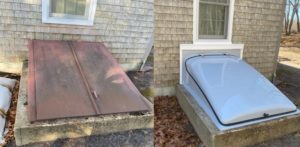nauset management blog
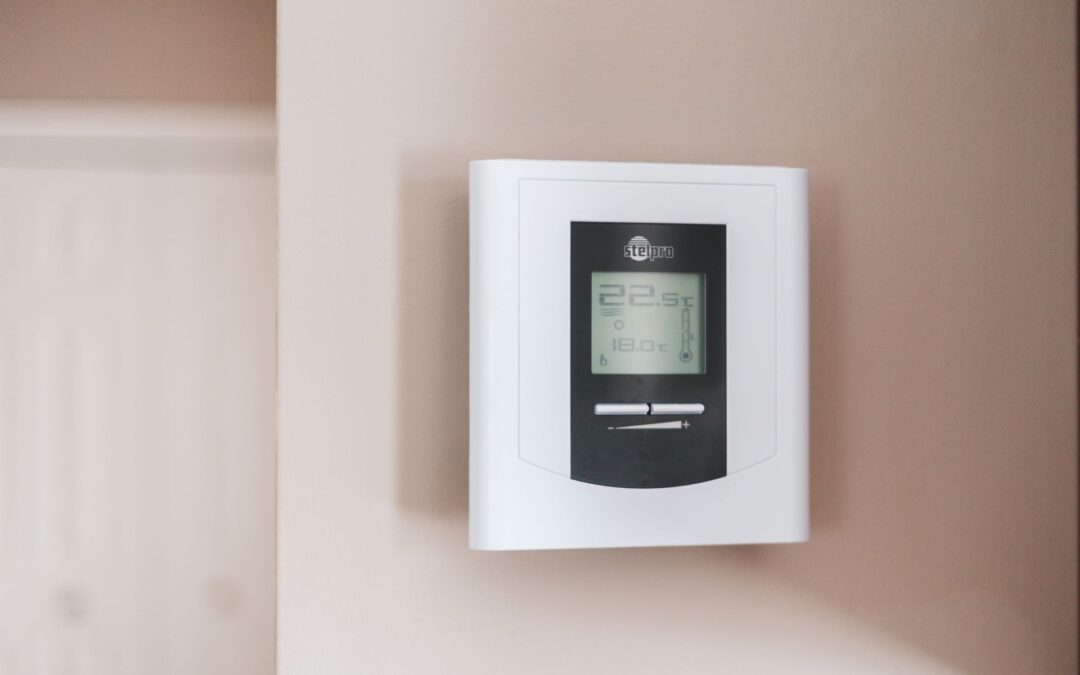
Auto Fuel Delivery
Years ago I had a customer call looking to move on from his oil provider and having turned him on to a reliable company, it was a few years later when the same customer called giving me a good hearted ribbing for the referral as they were running on fumes and fortunately had cause to head down to the basement and notice it before they were out in the cold. He was upset and looking to again switch up providers because he was on automatic delivery and clearly, they had dropped the ball. While very few oil and propane providers have hit or miss volume indicators, automatic delivery is based almost entirely on historic usage. In this case, my guy would check out on Labor Day, we’d dial the heat back to 52 and joke about hoping we wouldn’t talk until Memorial Day Weekend. It was on New Year’s Eve day when he glimpsed the gauge on the oil tank having arrived one week before Christmas with the family when 52 was bumped up to 70 and had remained there for two weeks.
Such as most with a history of vacating for the off season, oil and propane providers will work off historical deliveries. In this case, we were at 52 and would realize a top off every 3 ½ months. Needless to say, running 18 degrees higher for two weeks will bend that curve having of course disrupted the routine cycle.
Some time ago we endured a very atypical stretch of weather where we didn’t climb out of the 20’s for over two weeks. In spite of thermostats set in the typical 52 – 58 range, systems were working harder and longer to keep up and of course whenever I’d raise a flag when we approached a quarter tank, the response was “But we’re on automatic delivery.”
Bucking historical usage was commonplace during our Zombie Apocalypse where at one point upwards of 70% of my base was in house or on loan. A last minute weekend or cold snap isn’t going to turn the world upside down but for anyone here on an extended stay or renting in the off season which still has some appeal for the last of the remote workforce, remember that automatic is in fact an educated guess.
Water and Your Vacation Home
You can lead a horse to water but from time to time
It dies of dehydration at the river’s edge.
Jon Clark 1998
I have pitched this in one-on-one discussions countless times and whether it’s the disruption of routine brought on by an uptick in visits or loaning out houses during COVID, there are a remarkable number of homes that have the water on at the main which has absolutely zero upside.
In ideal situations, the first thing I do, unless told otherwise or if a home is on a Tiger loop*, is to turn on the water main or well tank. The first leg of the exercise is to wait until the flow stops which assures, we have zero breaches as the system is pressurized. Next, it will replenish any required make-up water that may have dissipated in forced hot water systems. I will then turn off the main and in cases of a well, I will turn off the shut off lever as well as the switch to the well pump. Throughout the course of the ensuing walkthrough, I will flush toilets [a byproduct is keeping rubber components wet rather than let them dry, crack and then leach water via seeping based on the decay] and open sinks to relieve pressure in the supplies. The premise here is that should we encounter conditions that would freeze up domestic and heat supplies, the diminished volume in the lines would not be enough to expand to a breaking point.
In a situation where we have a freeze up, the possibility would be revealed when the meter ceases to stop spinning…i.e. we never come up to pressure. At this point, I would seek turn off the main and out the breach, a vastly cleaner discover process rather than a two-week literal soak.
What spooks most from turning the water off is that forced hot water heating systems will not work. In cases where the main is off, forced systems would take weeks to months to become air bound to the extent that they would trip out. I have a handful of cases where geothermal systems and furnaces created in the same year steel was invented where the water stays on constantly but for all others, particularly force hot air systems, we’re flipping Mother Nature the bird leaving mains and wells on.
Having just left a basement, exterior access only, with about 8” of standing water, I figured I’d launch this PSA now rather than wait on the next riveting newsletter. I have never marketed from a perspective of fear and have no plans to do so but one of the biggest misconceptions is that if we aren’t below freezing, we can expect a steady diet of sunshine and lollipops and on the conservative side, I would say that about 75% of the calamities I’ve run into were in conditions north of 40 degrees.
I took a call in October from one of my favorite couples who I don’t typically start until December and when I was told of an outrageous electric bill, I knew we had an issue with the water pump. Sure enough…
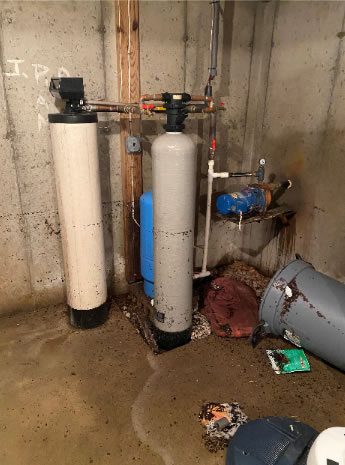
…the plug on end of the elevated water pump blew out and discharged water filling the basement until it shorted the pump out evidenced by the rust on the unit. Had that “light switch” between the two filter tanks been turned off, my dear customers may have been spared the hassle of switching out furnaces, a washer, dryer, pair of dehumidifiers and a handful of personal items.
This following is a typical municipal meter setup.
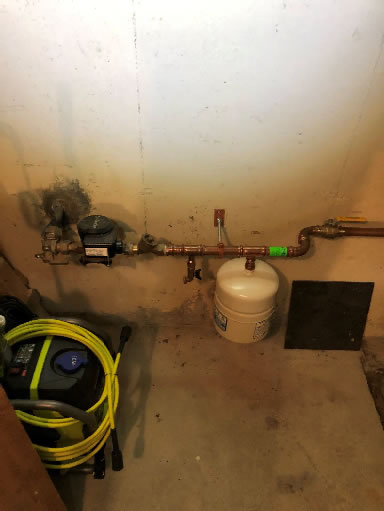
The physical meter is the black plastic component on the right. The rule of thumb is that should a pipe split, the town is responsible for anything from the street up to the meter. If the meter freezes, you own it. In turn, it is always wise to turn off the valve to the left of the meter between the foundation and actual meter. While setups will vary, the yellow lever on the right is a supplemental shutoff. While turning this off will isolate the house, a split from the meter to this supplemental valve will continue to provide water. These opposing shutoffs are designed to isolate both sides so that the meter can be removed. With both sides in the off position, the residual water in between is drained, in this case, by turning the blue valve on the spigot under the supply and to the left of the wall mount.
With a well system…
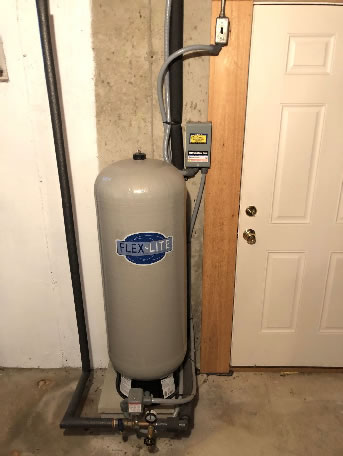
Turning the pump switch off keeps the carnage to that which is in the supplies as well as the tank. While tough to see, there is a shutoff valve to the left of the pressure gauge as well as a drain under the pressure gauge. Several years ago a last minute rental checked into a house in Eastham in mid-September hours after the cleaners had left and it wasn’t until the next morning when I received a call noting 6’ of water in the basement. After a silent eyeroll and making the mental adjustment to 6”, I made my way over to discover that it was closer to 8’ as only the top two treads of the basement stairs were dry. The washer, dryer, both plugged in, were enough to electrify the water. The issue was the bottom of the metal well tank had rusted through and with the pump on, the submersible unit [in the ground outdoors immune to tripping itself out] kept calling for water.
Again, I don’t stoke fear rather deliver calm but I want to reaffirm that mechanical issues occur year-round and have no regard for temperature and perception. I had four no heat calls for homes occupied during the holidays which of course always makes one wonder about the status of the much larger volume of unoccupied homes.
With the main or well off, I will detect a breach that can be located, isolated, cleaned up with a towel and repaired. Left unchecked under normal weather conditions for one or two weeks, we’ll need more towels. For 23 years, however chaotic or tame the season may be, mechanical failures consistently outpace weather related failures 2 or 3-fold.
As mentioned, having just left the home of a long time customer who we routinely shut off at the main, an uptick in occupancy and the burden of entering the basement from the exterior for the owner to access the main turned convenience into complacency for both of us and I couldn’t think of a more appropriate time to open the conversation or for most who have been with me for years if not decades, revisit old protocols. I will now open Pandora’s box and invite questions and concerns.
*The above-mentioned Tiger loop is a supplemental line that runs from the “house-side” of the water meter directly to the heating system which enables owners to isolate the house i.e. shut off the supplemental valve while assuring a continuous supply to the system. I’ve never seen the value here. In a best case scenario, the loop splits assuring water stays in the basement for the foreseeable future or worse, you have a split in the second floor base heat as everything freezes top down, and that loop will continue to supply water to try and keep up with the heat demand…definitely bigger towel time here having met customers on the heels of enduring such and event and even gutting some to the frame back when I’d break a sweat for a living.
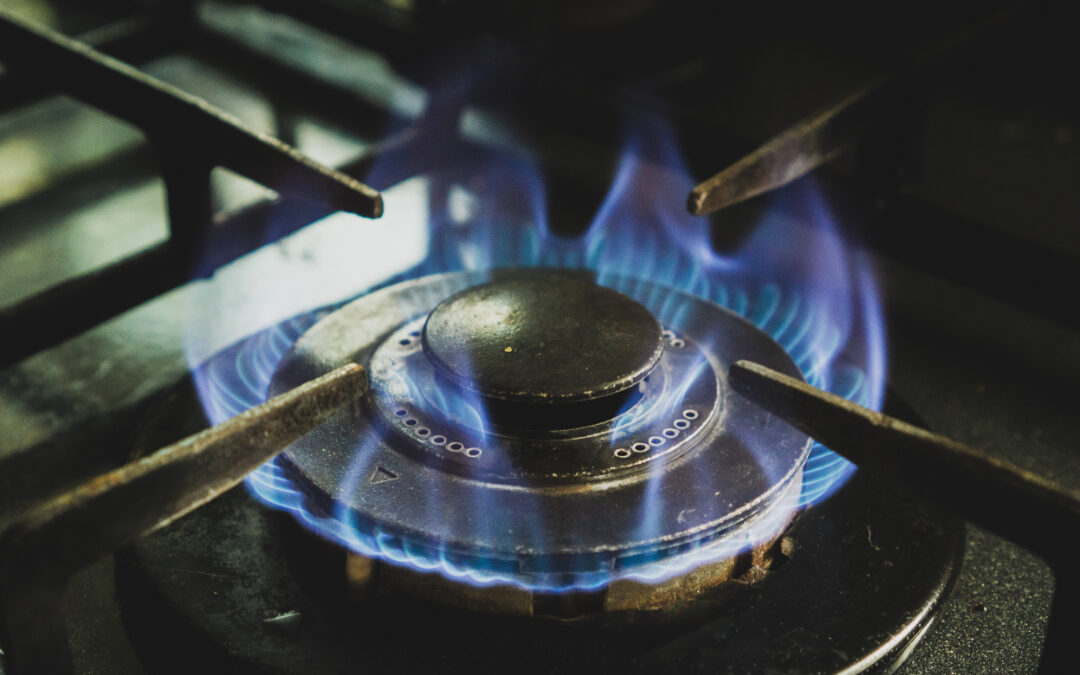
Carbon Monoxide & Your Vacation Home
While the Cape picks up snow, it seldom hangs around. Years ago, we picked up a stretch of moderate snow that came in bunches and never left during an uncharacteristic 2 – 3 week stretch of weather that poked it’s head above freezing with about as much frequency as lobster meat selling for under $50 per pound. About two days into the campaign with drifts that would leave me with the thighs of a Russian ballerina, I picked up a portable CO detector based exclusively on the chance that drifts may clog a gas vent creating a backup of CO inside the home. With nary a literal peep as season’s end, the unit ended up in my glovebox. The following year, right around Thanksgiving on a bright snowless day, it occurred to me that blocked vents aside, systems are running routinely and unless a home was recently sold, chances are they didn’t have tamper proof smoke and CO detectors. I fished the unit out of the back of the glovebox, powered it up, snapped it on and upon entering the first house on the route, I heard the first chirp and felt the first vibration since I pulled it out of its packaging. Taking a look, it was reading 20 or 20 PPM [parts per million].
0.5 – 5 is typical for homes without gas stoves such as the one I was in. Writing it off as flawed or an anomaly, I made my way to the basement as I’d done hundreds of times when the unit jumped to 45. Entering the mechanical room, it then jumped to 160. Home detectors will react to within an hour to an hour and a half at 100 ppm and will respond in approximately a half hour when exposed to 200 ppm and half the time, 15 minutes, when exposed to 200ppm. No more, no less curious as this point, I decided to see what happened on the next couple of stops to rule out a defect. At the very next stop, having never before occurred to me in the countless times I ran this sequence, I was struck by the fact that not only did the unit stay silent but the equipment and fuel source in house 2 were identical to the one I just left down to the brand and manufacture date. After an hour of subsequent checks with various systems and fuels sources and zero reaction from the portable detector, I doubled back to the first stop and the readings in each location matched the initial walk through. Having pitched the situation to Jim McDonnell of McDonnell Mechanical, he claimed he was in the area and would pop in and get back to me. About two hours later a very serious and almost stern Jim first asked if anyone was scheduled to visit however remote the possibility before telling me to stay out of the house until he gave me the OK. He had taken a reading at the core of the system that was topping out at almost 400 ppm. The issue was resolved and while I’m typically in and out of homes minimizing exposure, I wear it routinely if for no other reason than to pay it forward should it ever chirp. I can certainly speak to the fact that it surely is odorless and humbly suggest that the next time the batteries in the TV remote fail, poach replacements from anything other than smoke and CO detectors.
Potential symptoms after one hour of exposure:
0 – 9 ppm CO No health risk; normal levels
10 – 29 ppm CO Long term exposure may lead to nausea and headache
30 – 35 ppm CO Flu like symptoms develop, particularly among the young and elderly
36 – 99 ppm CO Flu like symptoms for all leading to nausea, headache, fatigue, drowsiness, vomiting
100+ ppm CO Severe symptoms, confusion, intense headache; ultimately brain damage, coma and/or death particularly at levels of 300 ppm and beyond

Racoon Proof Your Cape Cod Home
After 25 years of home watch service, checking attic gable vents, boots around roof penetrations, tampered chimney caps, pieces of asphalt shingles in the flowerbeds and of course discoloration on second floor ceilings is simply muscle memory.
The typical mating season on the Cape runs from January through the end of March though some claim this stretches into June; perhaps the hard to want crowd. During the nine week term from conception to birth, fiercely protective mothers will seek safe quarters and none better than an attic. In fact, left unchecked and/or marked, mothers will return season after season. I’ve had cases where insulation was replaced in order to remove the scent of the female while when ushering the mother out, male urine is often sprayed in the area as males will eat the young in order to begin the cycle over again. Females aware of the males will find a new nursery.
Raccoons need as little as 4” of daylight to find their way in and access is typically through attic louvers and the rubber gaskets around PVC vents through the roof. An unconventional compromise is in the chimney. If the damper is open all bets are off as it takes very little time for a raccoon to create a considerable amount of damage.
There are several measures that can be taken to assure these prospective timeshare owners set down roots at the neighbor’s.
How to get there – Raccoons will climb corner boards but the path of least resistance are branches. Trim everything at least 5’ from any roof surface.
Gable vents – These are the louver vents under the peak typically on each end of the house [the gable] designed to maintain circulation. These are often made of wood and will have simple window screening stapled to the inside to discourage bees, wasps, etc… PVC louvers will not only outlast the elements but aren’t nearly as tasty or comparably delicate as cedar. While PVC units may come with the gratuitous screen, apply ¼” wire to the face of the louver and secure it with screws and washers.
Chimney – Works for Santa. Even with dampers closed, raccoons with set up camp in the flu. The simple remedy here is a stainless-steel chimney cap and no coincidence given the time of year, Fowler Pest Control is in the spotlight this month and well versed at this application.
Food & Water – Trash barrels, water sources even bird feeders and seed will draw attention though for most watch/management customers, this isn’t an issue.
Deterrents – If your local hardware store is all out of male raccoon or coyote urine, ammonia is a simple turn off.
A Few Kind Words
Priced at the top of her potential, 43 Woodsneck was as clean as it gets in terms of following a typical Nauset Management listing.
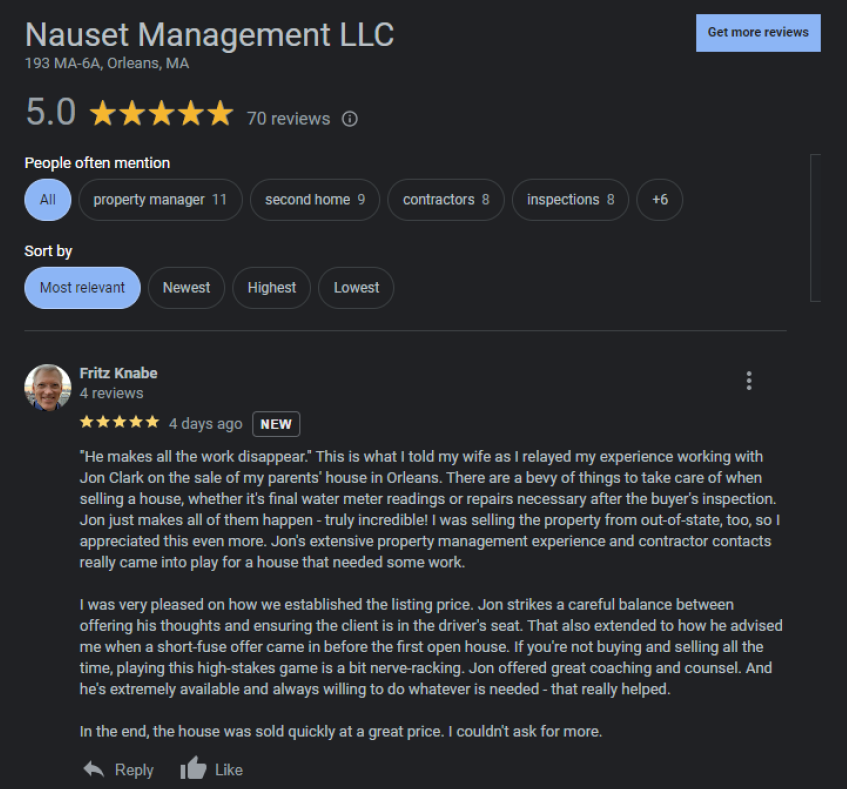
With the list price determined and cleanout underway, Jeff Marino at Rollaway Painting was on deck to refresh the interior. Throughout the 4-week process, I had coordinated and compensated the usual suspects starting with my cleaner [$475]. Next up the photographer [no iPhone photos for my listings] for the interior, exterior and drone shots as well as the floor plans and property specific website [$650]. FL Quinn conducted the required septic inspection which I always like getting out to the way immediately so that we might address any issues; none to be found [$550]. During the cleaning process, a bad solder was detected on a water supply in the basement; enter Dugas Plumbing [$220]. Next up… the case of the missing wi-fi thermostat; Purchase and sync McDonnell Mechanical [$1530]. New/code compliant smoke and carbon monoxide detectors; Paul McGrath [$600]. Fire inspection [$50]. Final water meter read [$40]. Final water bill [$55.81]. Grateful seller [beyond priceless].

Oil Tank Regulations – Orleans MA
September 2021
Orleans stumbled out of the gate with a change in how the town approaches oil tanks, specifically, single walled tanks. Such as most towns with a similar ordinance in place, Orleans would join the list of municipalities that would require that prior to closing on a property serviced by a single walled tank, ownership would be required to upgrade to a double walled tank. Exceptions to this rule would include the incoming buyer verifying in writing that he or she would take on the responsibility of the upgrade, often assumed as a negotiation tactic or in cases where the incoming buyer is converting to an alternate “fuel” source be it electric, natural gas, propane, etc.… Taking it one step further, Orleans scaled out mandatory deadlines.

Have granted access to many homes to prove/verify that tanks have been upgraded or systems have been converted to alternate fuel sources, it was acknowledged that a very poor database from generations gone by were the culprit coupled by modern day dysfunction exacerbated by a very ill worded and heavy-handed letter promising $250 per day fines unless or until applicable properties are brought into compliance. Regardless of install dates, deadlines and absurd threats and fines which have appalled full and part timers alike, should you enter into agreement, sign a proposal, with a vendor to complete the upgrade and submit a copy of the fully executed contract to the Orleans Fired Department, the penalties are waived through the stipulated installation date. Most oil providers offer this service though there are a few independents that switch out tanks routinely. If you have a single walled tank, establishing the installation date may be determined through your oil vendor or HVAC contractor either of which are far more reliable than the sparse database which again is the larger cause of the confusion and heavy language rather than the initial intent that is fuel spillage. If I may be of assistance or if you do not have an oil tank and need to prove it to the town, feel free to reach out and I will address it on this end.
Shocking
I’ve taken quite a number of calls in recent weeks in regard to notable increases in electric bills. Having spoken with a lovely representative, I was sheepishly told that Eversource has increased its per kilowatt hourly rate to 15.7 cents while the Cape Light Compact has taken an additional 14.6 cents per hour “…based on the demand for energy in light of the current situation.” Who knew COVID was causing a spike in electricity?
In addition, in the finest of print, the most recent invoice from the good folks at Eversource notes: “On Jan. 1, 2022, residential customers that receive their energy supply from Eversource using an average of 500 kilowatt-hours (kWh) of electricity per month, will see an increase of 25%, or about $30 per month, compared with December…”
Such as most, I have my utilities set on autopay which for me is akin to a colonoscopy to be scheduled and performed while asleep. In turn, I never gave it a second thought until the calls started rolling in.
Last, and for the wide-awake version of the above, the big, clunky and no doubt tone deaf utility then launched an email giving itself a hardy back-pat for community service noting in part…
Financial contributions: In 2021, Eversource employees and retirees raised $1.2 million for the United Way and other community agencies through its annual employee giving campaign. The Eversource Foundation also contributed $1.4 million – a $150,000 increase over the prior year.
Next Level
Certainly not your grandad’s bulkhead. The ClamDoor has been setting the standard for more than a decade. Born and raised in RI, these weathertight fiberglass units are finished in a smooth grey gel coat that is also agreeable to painting. We’ve replaced our fair share of Old Ironsides with these attractive, secure and smooth operating units. Backed by a 10 year warranty, the ClamDoor is a no brainer.


